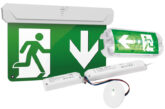
Self-test emergency lighting offers many advantages writes Scott Brewer, Head of Technical at Knightsbridge.
The growth in self-test emergency lighting has been well documented but primarily it has been seen as a way of keeping costs under control without sacrificing the element of safety that emergency lighting provides in buildings.
Though BS 5266 calls for a function test once a month and an annual full rated duration discharge is performed and logged for all emergency lighting installations, the costs of employing an engineer to come and do that can be prohibitive. Typically, a routine test would involve the following:
1. Turn off the local mains supply
2. Verify each luminaire is operating in emergency mode and meets the rated duration
3. Turn the mains supply back on and check that the luminaires are charging.
4. Record all results in an emergency test schedule report
And it’s not just the cost of an engineer but the hidden costs of downtime, loss of productivity and inconvenience to inhabitants or staff.
That emergency lighting fitted with self-testing control gear can perform some of these actions is clearly beneficial. As the name implies, an emergency light fitted with self-testing control gear can carry out the mandatory tests in accordance with national legislation, then report back the results via LED indicators, and in some cases, an audible alarm. Importantly all faults will continue to be indicated until they are rectified.
Therefore, the building owner or facilities manager now only has to check the LED status indicators and record the results on the test schedule. This results in a less labour-intensive testing procedure, leading to a quicker payback on the initial cost of installation, especially if you have a large complex building.
In addition to the reduced labour required to perform monthly checks, self-test luminaires also have the added benefits of:
a) Reducing human error in tests
b) Instant fault indication
c) Self-diagnosis identifies any component failure
d) No more delays in testing as it can be carried out within normal business hours
At Knightsbridge, our own self-test emergency lighting products offer the same all-important considerations of convenience, compliance, cost savings, and ease of fault identification. It’s a comprehensive, LED-powered range, which is ideal for retail, commercial, industrial and HMO applications, and comprises a robust bulkhead unit, a contemporary downlight, high lumen twin spotlights, and two lightweight exit signs.
The self-test feature is built into each product and conducts routine functional and duration testing in accordance with the relevant standards, obviating the need for costly manual testing and intervention other than to record and rectify faults.
After installation and an initial 24-hour charging period, each product conducts its own self-test operation. This consists of a three-hour duration test, after which a 30-second ‘monthly’ function test is carried out every 28 days, and then yearly another three-hour duration test. Following every self-test sequence, the unit will revert to charging mode.
The unit’s status and any fault modes are shown by the bi-colour LED indicator. A green light is displayed in normal running mode, while a red light operates to indicate the following: one red flash indicates a battery fault, two red flashes a lamp fault, and three red flashes a duration test failure. Manual initiation of the testing procedure is also possible should it be required. Further peace of mind is ensured by the three-year warranty that comes with every product.
View the Knightsbridge 2021 catalogue by clicking here









